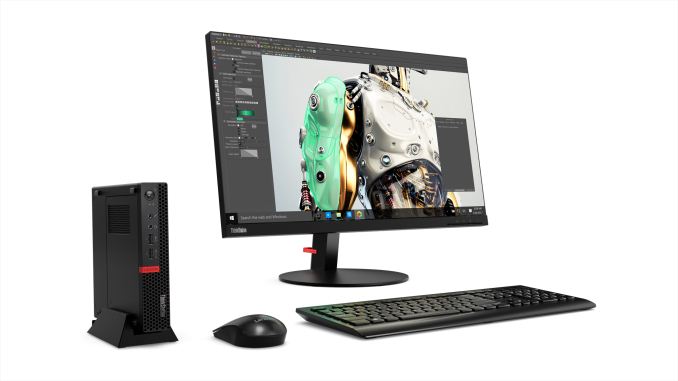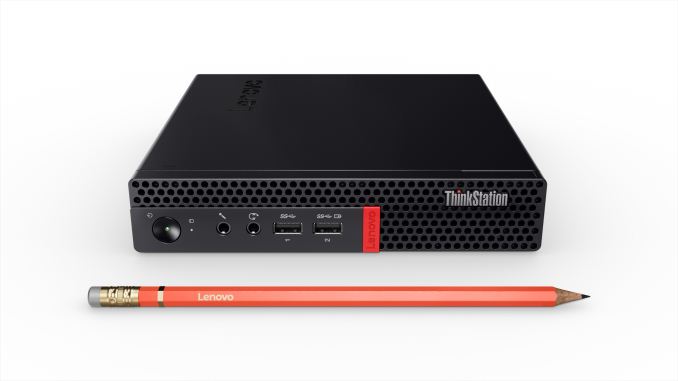Lenovo Unveils ThinkStation P320 Tiny SFF Workstation
by Ganesh T S on June 20, 2017 10:20 AM EST- Posted in
- Systems
- Intel
- Lenovo
- Quadro
- Workstation
- SFF
- NVIDIA
- Pascal
- ThinkStation
- Kaby Lake

Lenovo has unveiled a new ThinkStation model, the P320 Tiny, based on a Kaby Lake / Q270 platform with NVIDIA's Quadro P600 GPU. The unique aspect is the dimensions - At 1.4" x 7.1" x 7.2" (1L in volume), it is one of the smallest systems we have see that includes a discrete GPU. In order to achieve this compact size, the 135W power adapter is external to the system.
The P320 Tiny supports Kaby Lake CPUs with TDP of up to 35W (such as the Intel Core i7-7700T). NVIDIA's Quadro P600 is a GP107-based GPU with a 40W TDP. The system comes with two DDR4 SODIMM slots and two M.2 NVMe SSD slots. There is a rich variety of I/O ports - audio jacks in the front, a total of six USB 3.0 ports spread across the front and the rear, a RJ-45 GbE port, and six display outputs (4x mini-DP + 2x DP). Thanks to the Quadro GPU, the P320 Tiny is able to come with ISV certifications for various applications such as AutoCAD etc.
| Lenovo ThinkStation P320 Tiny: General Specifications | |||
| CPU | Intel Kaby Lake (up to Core i7) (35W TDP max.) |
||
| Chipset | Intel Q270 | ||
| RAM | Up to 32 GB DDR4-2400 (2x SODIMM) | ||
| GPU | NVIDIA Quadro P600 | ||
| Storage | 2x M.2 PCIe: up to 1 TB NVMe SSD each ODD: optional with add-on |
||
| Networking | Gigabit Ethernet Intel 802.11 ac, 2 x 2, 2.4 GHz/5GHz + Bluetooth 4.0 - |
||
| I/O | 6x USB 3.0 Serial - optional |
||
| Dimensions | 1.4" x 7.1" x 7.2" | ||
| Weight | 2.9 lbs | ||
The board used in the system seems to be a custom one - it is larger than a mini-STX board, but, smaller than an ITX one. It is perfect for space-constrained setups, and comes with extensibility options such as add-ons for extra USB ports and a COM port, or, for an optical drive, as shown in the gallery below.
As for operating systems, the new Lenovo ThinkStation P320 Tiny workstation supports both Windows and Linux. The P320 Tiny starts at $799 and is available now.

















26 Comments
View All Comments
DanNeely - Tuesday, June 20, 2017 - link
I'm starting to wonder what was it that made MiniITX stick as a major standard form factor, but every attempt to go smaller from Nano/PicoITX when Via/Centaur was a voice in the wilderness pushing tiny desktop form factors to miniSTX and another recent one whose name escapes me but which was intended as a "computer module" for third party all in one chassis.DanNeely - Tuesday, June 20, 2017 - link
... today have failed to gain any significant traction.MrSpadge - Tuesday, June 20, 2017 - link
At some point it becomes a lot more expensive to make things smaller. I suspect Mini ITX has reached that point for regular, somehwat modular PC components.Vatharian - Tuesday, June 20, 2017 - link
At this moment, yes, but the thing that's holding it is the real estate and dubious compatibility. For example, mini-STX has one big advantage over mini-ITX, which is fixed CPU socket location, and this is a must. But I have a feeling, that mini-STX isn't aimed at individuals, but rather large-scale system integrators, that can afford to manufacture their own chassis, or at least have them made to spec. Mini-ITX is the smallest we can do, given size of human fingers, using standard connectors. Even having angled ATX24 and EPS, and offloadong VRMs to daughterboards, and using underside of PCB (which is mostly out of ATX spec, btw) won't remedy this situation. Only way is to shift connectors: remove ATX24 altogether, and leave DC-in 12V jack only, switch to SO-DIMMs only, move SATA to angled connectors only, move PCI-Express to NGFF format (except main GPU port), and we're kinda better, but that requires changes, like limiting max CPU power to fit inside power delivery subsystem abilities (ruling out 160W little monsters like ASRock's X99-ITX/AC), and forcing GPU to get all the juice trough PCIe 6- and 8-pin connectors, which isn't viable now. Also moving all the IO to edge of Mini-ITX board will further decrease compatibility with chassis without much space around.In the end, I may be able to build E5-2699v4 with GTX1080 in 20x20x20cm cube, but it will be more engineering the solution, rather than system assembly.
Mini-ITX is the place, where you really, really clearly have to define your purpose and use case scenario(s), and then specialize, and this is hard choice for most consumers. It's impossible to build super-powerful PC in this format that will be quiet, and truly small, yet powerful PC will be either very loud, or extremely hot - and really no amount of money is going to change that, until you talk to ODMs like Kontron (who will happily design a motherboard for you).
ITX products have to fill a lot of niches, and in the end they need to be quality engineering applied, yet will sell in low numbers. Ever tried build an ITX PC, and recreate that build half a year later? Forget about it.
nirolf - Tuesday, June 20, 2017 - link
There is a less-known standard - thin-mini-ITX. I myself have built such a system for my living-room: fanless, Asus board (H81T) and an undervolted i3-4130T. It mostly has laptop parts: SO-DIMM, Mini PCI-Express slot for wireless, DC power connector. There are just a few products available, it's kind of like a niche of a niche market.nirolf - Tuesday, June 20, 2017 - link
An article about it: http://www.anandtech.com/show/4394/more-on-intels-...DanNeely - Tuesday, June 20, 2017 - link
Thanks. That was the standard I was blanking on.Samus - Tuesday, June 20, 2017 - link
+1 for Thin ITX. My HTPC/torrent server has that same Asus board with a Xeon 1230Lv3 (25w) passively cooled.There are even more extreme options, such as the Xeon 1220Lv3, which is 13w I think, but also incredibly slow, and at the time I was building a few years ago, unavailable and probably expensive. The Xeon 1230Lv3 cost $200 on eBay a few years ago, which is totally acceptable for what is essentially an underclocked i7, and to date, the most powerful sub-25w CPU you can buy. All the low-voltage Broadwell-based Xeons are 35w or higher :\
bug77 - Tuesday, June 20, 2017 - link
My guess is customizability is the reason. Sub miniITX cases simply do not allow much.jensend - Friday, June 23, 2017 - link
One reason others haven't mentioned is that below MiniITX size you're constrained by PSU size and the ATX12V connector. Smaller sizes really need external power bricks and a smaller power connector, but nobody's put in the work to get agreement/consensus/standards for that. Groups are too interested in pushing their own voltage, own connector, etc.